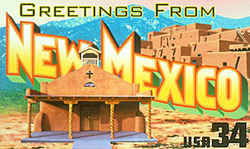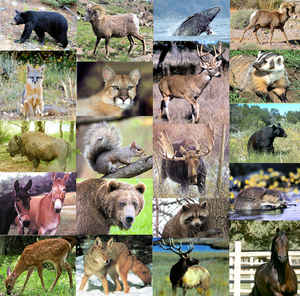
New Mexico Symbols
New Mexico State Animal
Black Bear

(Ursus americanus)
Adopted on February 8, 1963
The Black Bear, (Ursus americanus,) was adopted as New Mexico's Animal on February 8, 1963.
Smokey the Bear, probably the most famous bear in the history of the United States, was a New Mexico black bear cub found alive in a tree after a massive forest fire in the Lincoln National Forest near Capitan, New Mexico. In 1950, the US Forest Service and the Advertising Council utilized Smokey as the symbol for fire prevention campaigns conducted all over the country. Smokey received much notoriety, lived to a ripe old age, and was buried at Smokey Bear State Park in Capitan.
New Mexico State Animal: Black Bear

Bears are members of the Family Ursidae, in the Order Carnivora, in the Class Mammalia. Other families found within the Carnivora include the Canidae (dogs), Felidae (cats), Mustelidae (weasels), and Procyonidae (raccoons). The Ursidae family is of recent origin, believed to have diverged from the Canidae approximately 20-25 million years ago (McLellan and Reiner 1994). Black bears are 1 of 8 ursid species worldwide.
Characteristics of the New Mexico Black Bear

Large, powerful animals, black bears (Ursus americanus) weigh over 200 pounds. The largest recorded in New Mexico was 495 pounds. A "black"bear can be colored jet black to cinnamon, and there have been blonde-colored bears in the state. They have pointed noses and high-set ears. Claws are long, sharp and curved. Black bears can climb trees. Their lifespan in the wild can be long, and bears have been known to live 25 or 30 years in captivity. Adult female black bears normally give birth every other year to one to three cubs. The cubs, which weigh 8 oz. at birth, are born while the mother is in hibernation. The cubs remain with their mother during their first full winter, and disperse the following spring.
The name black bear is not a very accurate name for this species of bear. They can come in many colors such as black, brown, gray, silvery-blue, and cream. Most black bears are, in fact, black but often a black colored bear will have brown cubs and brown colored bears may have black cubs.
Behavior
Black Bears are good swimmers and can also climb trees. They have a good sense of smell but have poor eyesight. They are afraid of Grizzly Bears and stay far away from them.
Cubs
Two to three cubs are born during the winter while the mother hibernates. Cubs stay with the mother for about one year.
Diet
Being omnivorous (feeding on both plants and animals) and opportunistic, the black bear has a diet which varies according to seasonal availability of foods. They eat spring grass, berries, acorns, pinon nuts, and dead animals. Occasionally bears will kill livestock. At times they break into commercial beehives and remove honey and the bees. Rocks and stumps may be overturned in search of grubs, insects or small rodents. Recent research indicates they may also be an efficient predator of large game.
Reproduction
Females reach sexual maturity at 3 to 4 years of age and mating will take place in June, July and August. Pairs may come together for a few hours or several days, copulating many times. Gestation is approximately 220 days and the cubs are born in their mother's winter den in January or February. Cubs are weaned at around 8 months but may remain with their mother for a year and a half.
Social Organization
Black bears are usually solitary animals except females with young. A pair may come together for several days during mating season and in time of abundant food, several bears may feed closely together with little interaction. Male bears keep large territories that overlap the smaller ranges of several females. Bears will leave territorial signposts both through scent marking and by leaving long claw marks in tree bark.
Distribution
At least 2 million years ago, after radiating to North America from Asia, a small forest-adapted ancestor (probably Ursus abstrusus) gave rise to the modern American black bear (Stirling and Derocher 1989). Despite climatic changes and competition with various species, the black bear adapted to survive to the present day virtually unchanged from 1 million years ago (Stirling and Derocher 1989). Within their evolutionary history, black bears have coexisted with several other ursid species, including the extinct short-faced bear (Arctodus simus) and the extinct North American spectacled bear (Tremarctos floridanus). The brown bear (Ursus arctos), which coexists with black bears in northwestern regions today, radiated into North America only about 100,000 years ago, and probably reached the Southwest about 13,000 years ago. Since then, black and grizzly bears inhabited New Mexico and probably shared similar distributions. However, grizzly bears were extirpated from New Mexico by the late 1930's.
In New Mexico, evidence indicates black bear populations were greatly reduced by the early 1900's due to unlimited hunting and use of poisons (NMDGF 1926, Bailey 1932, Brown 1985).
Most forested areas of New Mexico are populated by black bears, and it is not uncommon to find them around mountain campgrounds, and even near large population centers. They need woodland cover, as they are shy animals and difficult to locate in the wild. Mixed forest with food-producing trees such as oak or pinon, are good areas in which to find bears. Bears like water to play in and to drink. They frequently wallow in springs and creeks.
New Mexico Law
The law designating the tarantula hawk wasp as the official New Mexico state insect is found in the 2013 New Mexico Statutes, Article 3, Section 12-4-4 E.
Chapter 12 - Miscellaneous Public Affairs Matters
Article 3 - State Seal, Song and Symbols
Section 12-3-4 - State flower; state bird; state tree; state fish; state animal; state vegetables; state gem; state grass; state fossil; state cookie;
state insect; state question; state answer; state nickname; state butterfly; state reptile; state amphibian; state amphibian; state aircraft; state
historic railroad; state tie; state necklace.
Universal Citation: NM Stat § 12-3-4 (2013)
12-3-4. State flower; state bird; state tree; state fish; state animal; state vegetables; state gem; state grass; state fossil; state cookie; state
insect; state question; state answer; state nickname; state butterfly; state reptile; state amphibian; state aircraft; state historic railroad; state
tie; state necklace. (2011)
A. The yucca flower is adopted as the official flower of New Mexico.
B. The chaparral bird, commonly called roadrunner, is adopted as the official bird of New Mexico.
C. The nut pine or pinon tree, scientifically known as Pinus edulis, is adopted as the official tree of New Mexico.
D. The native New Mexico cutthroat trout is adopted as the official fish of New Mexico.
E. The native New Mexico black bear is adopted as the official animal of New Mexico.
F. The chile, the Spanish adaptation of the chilli, and the pinto bean, commonly known as the frijol, are adopted as the official vegetables of New
Mexico.
G. The turquoise is adopted as the official gem of New Mexico.
H. The blue grama grass, scientifically known as Bouteloua gracillis, is adopted as the official grass of New Mexico.
I. The coelophysis is adopted as the official fossil of New Mexico.
J. The bizcochito is adopted as the official cookie of New Mexico.
K. The tarantula hawk wasp, scientifically known as Pepsis formosa, is adopted as the official insect of New Mexico.
L. "Red or green?" is adopted as the official question of New Mexico.
M. "Red and green or Christmas" is adopted as the official answer of New Mexico.
N. "The Land of Enchantment" is adopted as the official nickname of New Mexico.
O. The Sandia hairstreak is adopted as the official butterfly of New Mexico.
P. The New Mexico whiptail lizard, scientifically known as Cnemidophorus neomexicanus, is adopted as the official reptile of New Mexico.
Q. The New Mexico spadefoot toad, scientifically known as Spea multiplicata, is adopted as the official amphibian of New Mexico.
R. The hot air balloon is adopted as the official aircraft of New Mexico.
S. The Cumbres and Toltec scenic railroad is adopted as the official historic railroad of New Mexico.
T. The bolo tie is adopted as the official tie of New Mexico.
U. The Native American squash blossom necklace is adopted as the official necklace of New Mexico.
History: Laws 1927, ch. 102, § 1; C.S. 1929, § 129-101; 1941 Comp., § 3-1303; Laws 1949, ch. 142, § 1; 1953 Comp., § 4-14-3;
Laws 1955, ch. 245, § 1; 1963, ch. 2, § 1; 1965, ch. 20, § 1; 1967, ch. 51, § 1; 1967, ch. 118, § 1; 1973, ch. 95, §
1; 1981, ch. 123, § 1; 1989, ch. 8, § 1; 1989, ch. 154, § 1; 1999, ch. 266, § 1; 1999, ch. 271, § 1; 2003, ch. 182, §
1; 2005, ch. 4, § 1; 2005, ch. 254, § 1; 2007, ch. 10, § 1; 2007, ch. 179, § 1; 2011, ch. 52, § 1.
Taxonomic Hierarchy: Black Bear
Kingdom: Animalia
Phylum: Chordata
Class: Mammalia
Order: Carnivora
Family: Ursidae
Genus: Ursus
Species: U. americanus







